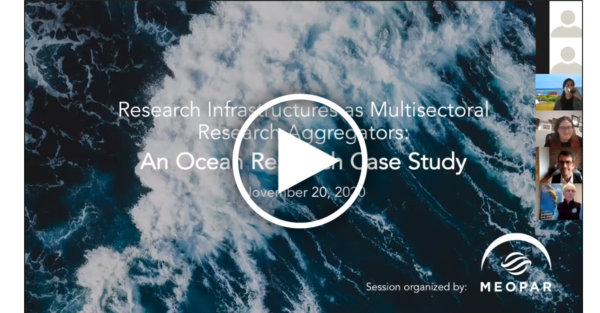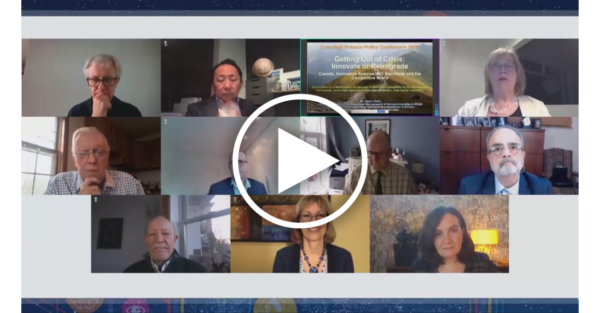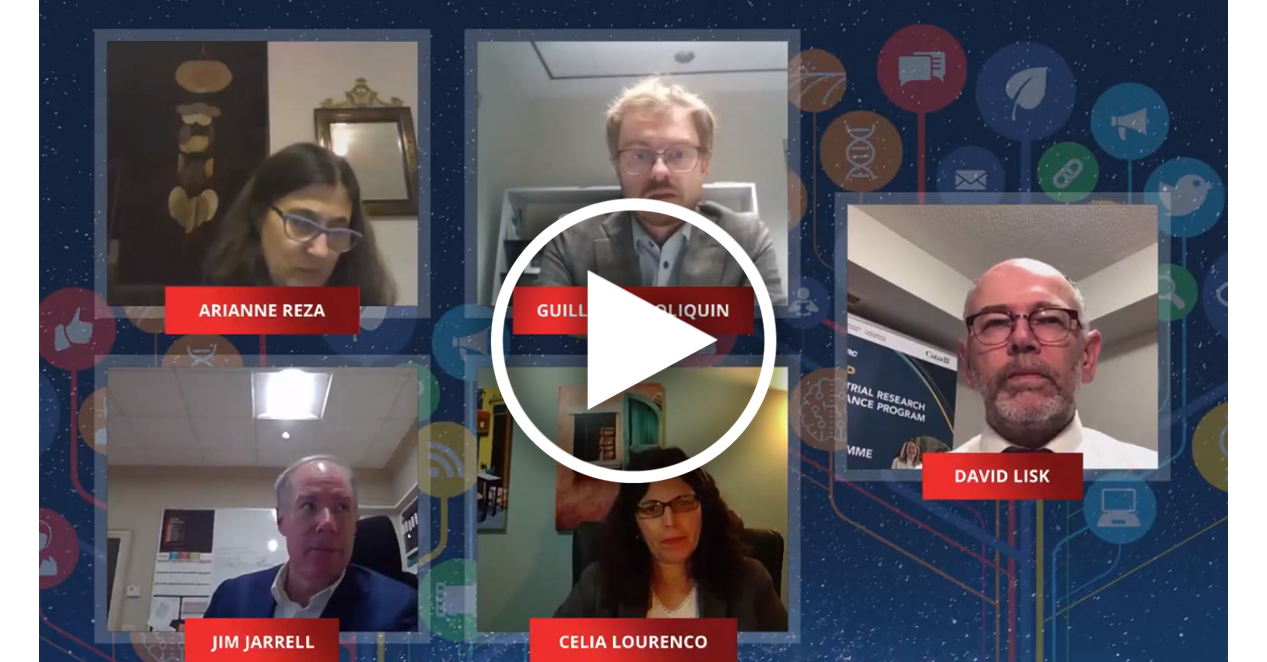The following are the CSPC 2020 panels that cover
Strengthening Innovation and Productivity
Pre – Conference Day 5 – November 20th 2020
Organized by: MEOPAR
Panelists:
Kathryn Moran – President and CEO, Ocean Networks Canada
Sara Iverson – Scientific Director, Ocean Tracking Network, Dalhousie University
Marcel Babin – Canada Excellence Research Chair, Takuvik International Research Laboratory, Université Laval and CRNS
Paul Snelgrove – Professor of Ocean Sciences and Biology, Memorial University of Newfoundland
Doug Wallace – Scientific Director, MEOPAR Network of Centres of Excellence
Jennifer Vollrath – National Manager, Science Assets and Infrastructure, Fisheries and Oceans Canada
Claire Samson – Vice President, Programs and Planning, Canada Foundation for Innovation (CFI)
Context: The panel brought together leaders of the three ocean-related CFI supported Major Science Initiatives as well as an experienced manager of DFO’s national infrastructure. The panel also included two PIs of national research networks and a representative from CFI, Canada’s major funder of research infrastructure funding. Collectively, the panel represented more than half-a-century of experience of management of major infrastructure and research networks in Canada. The panel provided a rare opportunity for policy recommendations arising from extensive hands-on experience to be presented and discussed together. There was notable convergence of opinion and general agreement on recommendations.
Takeaways:
- Major research infrastructures provide valuable opportunities to aggregate Canada’s otherwise geographically-scattered and sometimes siloed research expertise to tackle complex problems. They also provide value to multiple sectors of society, as well as training grounds for the next generation of researchers, and position Canada to be a global leader in ocean science.
- Structured funding models that support not only the acquisition, operation and maintenance of infrastructure but also support researchers to access and use it, are the key to maximizing their value and effectiveness. The Ocean Tracking Network’s experience with a one-time paired funding model involving CFI, the Natural Sciences and Engineering Research Council and the Social Sciences and Humanities Research Council allowed them to establish global leadership for Canadian science and maximize the return on the infrastructure investment.
- Multisectoral partnerships can be of great value for acquisition, operation and maintenance of major research infrastructures. Amundsen Science’s partnership with the Canadian Coast Guard is an example of how platforms that support government missions can be combined effectively with research use.
- Sustained funding of research infrastructures enables development of partnerships that extend far beyond the research community. For example, Ocean Networks Canada’s operation of research infrastructure has led to progressive development of user communities that now include coastal communities, industry, governments and indigenous communities in addition to researchers. However, development of these partnerships requires long-term, sustained funding.
- In the case of research vessels, their cost and the potential for shared use requires multisectoral and long-term planning, as is common in many other countries. MEOPAR has established the National Research Vessel Task Team, with broad membership, to promote this at the Canadian national scale.
- DFO also recognizes the value of a coordinated approach to infrastructure and recently launched the Canadian Ocean Infrastructure Portal. The COIP provides a national approach to coordinate access to and optimize the use of large-scale ocean infrastructure. The initial phase of development of this online tool aims to: 1) facilitate and standardize the annual ship time application process on Canadian Coast Guard science ships; 2) optimize the ship scheduling process; and 3) inform the ocean science community and promote collaboration by disseminating scheduled for science missions at-sea.
- National research and training networks have proven valuable for overcoming barriers to shared use of research infrastructures. Several examples were presented of how national networks have combined with infrastructure programs and delivered major success. These examples have to date usually been topic-, discipline- or infrastructure-specific. The experience of ArcticNet and MEOPAR is that the Network of Centres of Excellence model, with a time-horizon of 15 years, was well matched to this task.
Actions:
- Specifically for support of Canada’s research in the Arctic, there is now an urgent need to plan for replacement of the CCGS Amundsen whose lifetime is unlikely to extend beyond 10 years. Existing plans for icebreaker construction could usefully be aligned to meet this need.
- The widespread dependence on provincial contributions for matching funds creates significant challenges in some region that risks insufficient leveraging to support development infrastructures of national or global significance. A regular workshop or communications program to highlight the broad value of research infrastructures for diverse partners and sectors would help broaden the range of users and financial supporters.
- Closure of the NCE program implies the need to develop a new model and funding instrument. Such a model should connect the broad range of sectors involved in Canadian ocean research. One possibility would be to empower (and fund) the Ocean Research in Canada Alliance (ORCA) to fulfill this role. However the present configuration of ORCA, with very limited personnel and funds, is insufficient to tackle these gap by itself.
- The panelists agreed that it makes sense to tackle challenges together and initiate a joint dialogue with policymakers in order that pathways forward can be crafted based on collective experience. The panel suggested that recommendations arising from the operation of the research infrastructures and related networks should be communicated to the policymakers responsible for science funding, including the Canada Research Coordination Committee.
Conference Day 2– November 17th 2020
Organized by: Competitive Innovation Management & Entrepreneurship Inc.
Panelists:
Anthony McCauley – Strategy Advisor, Skillnet Ireland
Belen Suarez – CEO, Reacción Economica
Bruce Farquhar – Director, Global Standards, Standards Council of Canada
Hamid Etemad – Professor of International Business and Marketing, McGill University
Hiro Nishiguchi – CEO, Japan Innovation Network
Irene C Makar – Director, Strategy and Innovation Consultant, Dalcor Innoventures Ltd.
Michel Bergeron – Chief Strategy Officer, Business Development of Canada
Peter Merrill – President, Quest Management Inc.
Rick Fernandez – President, 20-20 Innovation, Inc.
Sorin Cohn – Founder and CEO, c-IM&E Inc. (Competitive Innovation Management & Entrepreneurship Inc.)
Sylvie Plante – Principal Consultant, Sylvie Plante Enterprise Channeling Inc.
Victoria Lennox – Chair / Principal, Lennox Foundation / The Lennox Group
Context: This interactive panel discussed plans from the US, Japan, Europe and Canada to mobilize the science of innovation management –specifically recent ISO 56000 standards – to enhance investment and competitiveness. The panel examined the value of policies and programs that support wide-spread training and application by governments and industry of the new ISO innovation management system and associated standards, which apply to issues such as innovation partnerships, intellectual property management, idea management, innovation measurements and metrics.
Takeaways:
- Standards are essential in the innovation sector. They enable the establishment of new markets and technology platforms, and help to achieve business goals, attract financing and improve competency.
- Canada has an innovation management gap that hinders our innovation and competitiveness. This can be addressed by incorporating the ISO 56000 family standards across all industries and the public sector.
- ISO 56000 has the ability to scale and strategically deliver and is a globally accepted system approach between private, public and social sectors in managing innovation, closely aligned in fulfilling the UN Sustainable Development Goals.
- COVID-19 has put a greater focus on the role of science, technology and innovation policies in scaling up technology firms, and in understanding the return on investment from R&D (i.e., emphasizing outcomes that generate higher impacts).
- Post-COVID-19 demands include: less time spent on research; a greater focus on problem solving; commercializing innovation within an ecosystem of three or four networked actors; and greater collaboration between academic institutions, different levels of government and global institutions.
- Relationships between and within communities and organizations can build trust and give rise to various forms of social capital that contribute to adaptive strategies and innovative solutions, such as social innovation, better knowledge management and digital skills.
- Managing small- and mid-sized company entrepreneurship and innovation can be effective using a business model innovation approach, which tests feasibility, desirability and viability.
Actions:
- Innovation management needs to be considered a building block of Canadian innovation science.
- Government and other stakeholders should be trained on how to effectively utilize ISO 56000.
- Small- and medium-sized entrepreneurs form 99.8% of Canadian businesses and therefore, they need knowledge and training on innovation management, starting with incremental innovation.
Conference Day 3 – November 18th 2020
Organized by: Mitacs
Panelists:
Daniel Munro – Senior Fellow, Innovation Studies, Munk School of Global Affairs and Public Policy, U of T
Grace Quan – CEO, Hydrogen in Motion
John Hepburn – CEO and Scientific Director, Mitacs
Wendy Cukier – Professor of Entrepreneurship and Strategy, and Founder of the Diversity Institute, Ryerson University
Context: There has arguably never been a time when human and intellectual capital have meant more to national prosperity than they do today. Canada is competing in an increasingly fast-changing, knowledge-driven, and interconnected world. Future prosperity depends increasingly on using innovation to capitalize on the transformative potential of big ideas. And yet Canada’s innovation performance continues to lag that of many of our peer nations. Reversing this trend will require concerted effort in many areas, and one of the most important of these is skill development. Our ability to innovate depends fundamentally on the ideas, energy, and talents of individual innovators. Panelists discussed how Canada can best develop the skills needed most to improve its innovation performance.
Takeaways:
- Canada has one of the highest levels of education in the world, but the level of innovation does not seem to match— innovation being defined as the generation of new value, including both social and economic value.
- Canada is comprised of mostly small enterprises. Yet highly skilled labour is expensive and needs large companies to support that cost. The lack of Canadian presence among large 500+ employee companies is partly due to diluting of Canadian funding, as early stage enterprises are being quickly acquired by other countries.
- Entrepreneurial ambition is very high in Canada, but the actual rate of entrepreneurship is mediocre, possibly due to lack of opportunity for acquiring appropriate skills.
- Including social innovation improves the inclusion of less represented groups in entrepreneurship, such as women, Indigenous peoples, and those with non-STEM backgrounds.
- Intellectual property protections in Canada may be lacking in both patenting ideas as well as protecting existing patents. Maintaining IP can be extremely costly for smaller enterprises.
Actions:
- To support innovation in Canada, it must be more inclusive, such as expanding beyond STEM, which due to systemic biases may be less accessible to certain populations such as women and Indigenous peoples. Mitacs is already moving to adopt a more inclusion approach as part of its effort to involve students from other disciplines.
- The skills that are needed to drive innovation and support entrepreneurship need to be developed. In particular, fundraising, collaborating and communicating in a team setting, and understanding intellectual property/patenting are key to entrepreneurship.
- Responsibility for skills development falls not only on post-secondary education; it also needs to be supported by Canadian firms through professional development. Government can play a role in offsetting some these training costs, especially for small companies.
- Beyond representation in the field, inclusiveness also needs to address compensation and feelings of empowerment within the organization. Employers should include diversity targets for employment and take into consideration systemic issues. For example, needs such as maternity leave and childcare will frequently impact women’s career trajectories negatively. When these issues are addressed, innovation benefits.
Conference Day 2 – November 18th 2020
Organized by: UKRI
Panelists:
David Lisk – Vice-President, Industrial Research Assistance Program (IRAP), National Research Council Canada (NRC)
David Golding – Head of North America and Global Networks Innovate UK, Innovate UK
Lisa Cashmore – Vice President, Communitech
Irene Graham Obe – CEO & Board Director, ScaleUp Institute, UK
Maxine Adam – Head of Business Growth, Innovate UK
Kim Morouney – Managing Director, Lazaridis Institute
Adam Hale – Chair of the ScaleUp Institute and a Board Advisor to scaleups at the ScaleUp Group and an Associate of Oxford Said Business School’s Creative Destruction Lab
Andy Richards – Chairman of Arecor, Congenica, Abcodia, Closed Loop Medicine and The Babraham Research Campus
Context: High growth and scaling business play an important part in the economic growth of countries. Canada and the UK are both good at generating start-up businesses but face more of a challenge when it comes to the growth and scaling of those businesses. The panel examined developments in both countries and the challenges science-based businesses face (compared to those not coming out of the science base) to grow and scale globally and what policy interventions can be used to help them on their scaling journey.
Takeaways:
- Only 42% of UK start-ups survived to scaleup in 2016 yet scaleups remain the biggest contributor to growth nationally among SMEs. (e.g., UK scaleups breaking $10 million have risen 37% in 2020.)
- The main scaleup challenges are talent, markets, leadership capacity, finance and infrastructure.
- Government-funded programs like IRAP and Innovate UK play an important role in providing funding, advice and innovation support that helps scale SMEs.
- CEO peer networks draw on the expertise of those who have led development to drive programs for development.
- Highly customized support of high growth SMEs is required; a blanket approach doesn’t work.
- Peer-to-peer networks support the flow of ideas, communities of success, and skills development, as well as inspirations for success.
Actions:
- To grow SMEs, support the main drivers of drivers of growth: knowledge sharing, active university engagement, local ambition and active stakeholders.
- Scaleups also require tailored business development, mentorship, and technical feasibility to be successful.
- Train founders and executives to transition from founder-led to scalability and repeatable processes. This may require transforming innovators into CEOs.
- Invest in and develop a critical mass of successful scaleups to help companies grow in Canada.
Conference Day 1 – November 16h 2020
Organized by: National Research Council Canada
Panelists:
Michel M. Dumoulin – Vice-President Engineering, National Research Council of Canada
Ben Sparrow – CEO and Co-founder, Saltworks Technologies
Phil De Luna – Program Director, Energy Materials Challenge Program, National Research Council of Canada
Jennifer Wagner – President, CarbonCure Technologies
Frank Des Rosiers – Assistant Deputy Minister, Strategic Policy and Innovation Natural Resources Canada
Michael Ross – Industrial Research Chair, Northern Energy Innovation Natural Sciences and Engineering Research Council
Carolyn Fischer – Senior Fellow, Resources for the Future
Context: The panel explored what is needed from a regulatory and policy perspective to decrease greenhouse gas (GHG) emissions by growing Canada’s clean tech ecosystem, particularly small- and medium-sized enterprises. Issues discussed included the social science challenges of deploying and implementing clean tech, Indigenous inclusion in clean tech, and how collaboration among public sector R&D actors is strengthening the ecosystem in the areas of clean fuels, energy efficiency and renewables. Particular attention was paid to the clean tech sector’s role in economic recovery in response to COVID-19, and how the pandemic has impacted the Government of Canada’s work in supporting this sector.
Takeaways:
- Collaboration is key. Public sector R&D actors, small to large companies, early adopters, investors, academia and local communities can accelerate clean tech deployment and adoption across the supply chain in areas such as clean fuels, energy efficiency and renewables.
- Carbon capture and conversion, clean hydrogen production and artificial intelligence for materials discovery can contribute to GHG emission reduction.
- Collaboration around a specific problem such as carbon removal technology can accelerate a solution that no one group can develop on its own. For earlier stage technologies, government and national labs play a valuable role in moving technologies up the Technology Readiness Levels.
- Establishing good regulatory practices and frameworks that are affordable, effective and consider the contexts of the diverse sectors of the economy can help de-risk and grow the clean tech sector, decrease GHG emissions and attain other UN Sustainable Development Goals. An effective framework is one informed by the social sciences (i.e., in addressing deployment and implementation barriers), Indigenous knowledge and needs, and the social impacts of climate change on vulnerable populations.
- No one size fits all. A basket of policies and other solutions is needed to address the needs of different communities, local circumstances and sectors. For example, small modular reactors are one potential solution, but bringing this technology and other cleantech to the north faces many logistical challenges, such as transportation, operation and maintenance, replacement, etc.
Actions:
- To help Canada reach its 2050 goals of net zero emissions, the clean tech sector needs an ecosystem-based approach and market-based solutions that de-risk and accelerate clean tech solutions. This includes supportive regulatory frameworks and policies (e.g., carbon offsets, Environmental Product Declarations), incentives for early adoption, and private sector investment (e.g., sustainability funds for green technologies).
- Establish a task force for climate disclosure. Since you can’t fund what you can’t measure, climate risk and mitigation needs to be part of capital investment.
- Empower vulnerable populations by including communities in the conversations and actions; build trusting relationships with communities.
Conference Day 3 – November 19th 2020
Organized by: Global Affairs Canada
Panelists:
John Sarrao – Deputy Director, Science, Technology, and Engineering, Los Alamos National Laboratory
Myrriah Tomar – Director, Office Science & Technology, New Mexico Economic Development Department
Eric L Sanchez – Director, Physical Science Laboratory, New Mexico State University
Geoff Freeze – Manager, Advanced Nuclear Fuel Cycle Technologies, Sandia National Laboratories
Scott McLaughlin – Acting CEO and Director of Business Development, Spaceport America
Dina Santos – Consul and Senior Trade Commissioner, Consulate General of Canada in Dallas, Texas
Eric J Felt – Commander, Phillips Research Site and Director, Air Force Research Laboratory Space Vehicles Directorate, Kirtland Air Force Base
Steven J Stochaj – Physicist, Klipsch School of Electrical and Computer Engineering, New Mexico State University
Context: The session featured cutting edge research occurring in the State of New Mexico to power the next phase in space exploration. New Mexico is home to world-renowned institutions such as the Los Alamos and Sandia National Laboratories. Working with entities including NASA and private industry such as SpaceX and Virgin Galactic, these institutions are on the forefront of energy research and space exploration. As good ideas have no national boundaries, the session will help inform Canada’s $2 billion investments over the next 24 years in space-related projects.
Takeaways:
- Sandia National Laboratory has a strong track record with the safety analysis of various space launches and is working on nuclear payloads launch safety analysis.
- The Physical Science Laboratory, New Mexico has active programs focused on aerospace, telemetry and missiles, as well as information sciences and security services.
- Spaceport America has the infrastructure for testing space flights, parachutes, manufacturing systems, and space launches, and is working towards developing commercial space flights.
- Airforce Research Lab advances innovation in multiple space-related areas, and works closely with private entities for satellite launch and operations.
- Partnerships between government and commercial ventures are critical for the future of space exploration. For example, Los Alamos works closely with other laboratories in New Mexico (e.g., Sandia National Laboratories), and both Los Alamos and Spaceport America collaborate with Canadian partners.
Actions:
- Continue working towards integrating engineering and science for the success of current and future space programs.
- Nuclear safety and space launch tests are critical for the growing space exploration market.
- Promote research collaborations and MOUs between laboratories in New Mexico and Canadian/international researchers based on shared interests.
- Key technology enablers are needed for better management of space traffic and debris mitigation in space.
- Develop protocols and strategies to establish standards for low-altitude space management to avoid collisions in low-orbit.
Conference Day 3 – November 18th 2020
Organized by: École Nationale d’Administration Publique
Panelists:
Eric Dion – Contract Professor, École Nationale d’Administration Publique
Conference Day 2 – November 18th 2020
Organized by: Public Administration, University of Ottawa
Panelists:
Shirley Anne Scharf – Ph.D. Student, University of Ottawa
Conference Day 4 – November 19th 2020
Organized by: National Research Council Canada
Panelists:
David Lisk – Vice-President, Industrial Research Assistance Program (IRAP), National Research Council Canada (NRC)
Roger Scott- Douglas – Acting President, National Research Council (NRC)
Arianne Reza – Assistant Deputy Minister, Procurement, Public Services and Procurement Canada (PSPC)
Guillaume Poliquin – Acting Scientific Director General, National Microbiology Laboratory, Public Health Agency of Canada (PHAC)
Celia Lourenco – DG, Biologic and Radiopharmaceutical Drugs Directorate, Health Products and Food Branch, Health Canada
Jim Jarrell – President & Chief Operating Officer, Linamar Corporation
Context: The COVID-19 pandemic has highlighted the role of public R&D institutions in mobilizing the innovation community. Representatives from both public and private institutions discussed: (1) what needs were faced at the outset of the pandemic (e.g., testing, therapeutic equipment, personal protective equipment (PPE), modeling) and what were our gaps; (2) what form of science and technology was needed to address the pandemic (e.g., at hand, applied, resident or build upon ready) and on what timeline (right now, or near term); and (3) what was done (e.g., refocusing of staff, facilities, and experts, innovative procurement, IRAP and NRC challenges) to respond.
Takeaways:
- Public R&D institutions play a critical role in mobilizing the innovation community. Canada’s federal science departments and agencies responded quickly in the early days of the pandemic with new support programs for a range of immediate health and economic needs (e.g., scaling up testing, production of therapeutic and PPE, establishing the Vaccine Task Force)
- Domestic supply chains are extremely important, yet can be fragile in times of crisis. Competition for scarce supplies resulted in shortages of essential products. Traditional suppliers and supply chains changed and in some cases were repurposed which increased costs. It took time to shift from a competitive to a more collaborative approach.
- During times of crisis, procurement and regulatory processes need to be innovative, adaptable, fast and require a whole-of-government collaborative effort. For example, when faced with a shortage of reagents needed for COVID-19 testing, a retired scientist was invited back to develop a new reagent, which was then mass produced by a domestic supplier.
- A crisis management protocol developed at the international level for the Zika virus, and used during this pandemic, includes many best practices that could assist Canada.
- A challenge can break down barriers and silos within companies and organizations, with all people and resources focused around a common need. The challenge going forward is to find ways to maintain and expand this connectivity across supply chains, government departments and other stakeholders.
Actions:
- Understanding capacity and capabilities is critical. Government departments and agencies need to develop a database of current staff, equipment and infrastructure assets that could be deployed if needed. A similar exercise would be valuable for academic institutions and laboratories, as well as companies and their supply chains.
- Scenario planning is important. For example, how do we prioritize, manufacture, store and distribute a vaccine, and how do we support testing. What will the new normal be? Will processes and approaches put in place during the pandemic continue in some form? (e.g., flexible work arrangements, virtual platforms, modified procurement processes)
- Find a way to bring all different pieces together across supply chains and government departments to make them competitive nationally and internationally. Develop innovative programs to support supply chains, including domestic manufacturing and production capabilities.
- Encourage interdisciplinary, convergence-based research and information sharing and align regulatory processes across countries for product development.
Conference Day 2 – November 17th 2020
Organized by: Simon Fraser University
Panelists:
Véronik Campbell – RADIUS Associate Director, Labs, Beedie School of Business, Simon Fraser University












